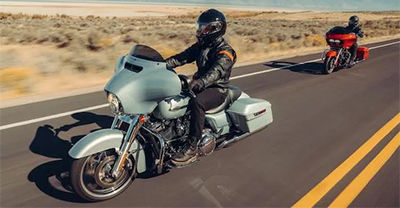Riding a motorcycle across state lines is an incredible experience, whether you’re heading out for a weekend road trip or crossing multiple states on a long-distance adventure. But what happens if you get into an accident outside your home state? Will your motorcycle insurance still cover you, or will you run into unexpected complications?
For motorcyclists who love to travel, the question of whether motorcycle insurance provides coverage across state lines is an important one.
But what happens if you encounter a mishap outside your home state? Will your motorcycle insurance still be in effect or will you run into unexpected complications?
Let's explore how motorcycle insurance typically works out-of-state, the factors that influence coverage, and what steps to take if you’re in an out-of-state incident.
UNDERSTANDING MOTORCYCLE INSURANCE COVERAGE ACROSS STATE LINES
The good news is that most motorcycle insurance policies are designed to follow you no matter where you go within the United States. This means your coverage typically remains valid across state lines. However, there are important nuances to keep in mind:
Liability Insurance: If you cause an insurance incident in another state, your liability insurance may adjust to meet the minimum requirements of that state. For instance, if you travel from a state with a lower liability minimum (e.g., $25,000 in bodily injury per person) to a state with a higher minimum (e.g., $50,000), your policy may automatically increase to meet the higher limit. (Be sure to verify with your insurance provider).
Comprehensive and Collision Coverage: These types of coverages, which protect against damages to your bike, typically remain unchanged regardless of the state you're in.
Underinsured Coverage: If the incident involves an uninsured or underinsured driver, your policy’s uninsured/underinsured motorist coverage may help protect you. Additionally, if your policy includes medical payments it can assist with medical expenses no matter who was at fault, which is especially useful in states with different fault laws.
Be sure to review your policy details and consult your insurance provider to confirm the specifics of your coverage.
STATE LAWS VS. INSURANCE POLICIES: KEY DIFFERENCES
Each state has its own insurance laws and requirements, which may differ significantly from your home state. For example:
Minimum Liability Requirements: Some states have higher liability minimums, which your policy will need to meet if there is an insurance mishap there.
Helmet Laws: Be sure prior to traveling out of state you understand the helmet laws.
Understanding these differences before you travel can save you from unexpected complications.
WHAT TO DO IF YOU HAVE AN INSURANCE EVENT IN ANOTHER STATE?
Getting into an unplanned mishap out of state can be stressful, but taking the right steps can simplify the claims process. Here’s what you should do:
Ensure Safety First: If possible, move yourself and your bike out of traffic to prevent further harm.
Check for Injuries: Check yourself and others for injuries. Call 911 for medical assistance if needed.
Document the Scene: Take photos of the scene, including damage to your bike, other vehicles, and the surrounding area.
Exchange Information: Collect the contact and insurance details of everyone involved.
File a Police Report: In most states, you’ll need a police report to file an insurance claim.
Contact Your Insurance Company: Notify your insurer as soon as possible and provide all relevant information.
Your insurance company will guide you through the claims process and clarify how your policy applies to the incident.
HOW TO PREPARE FOR AN OUT-OF-STATE MOTORCYCLE TRIP
A little preparation can go a long way in ensuring you’re protected and ready for any situation while traveling. Before hitting the road, consider these steps:
Review your insurance policy – Make sure you understand your coverage, including any limitations when riding in other states.
Increase coverage If needed – If you’re taking a long-distance trip, consider increasing your liability, collision, or medical coverage for added protection.
Carry important documents – Keep a copy of your insurance card, registration, and emergency contact details with you at all times.
Know the local laws – Research the helmet laws and other state-specific traffic regulations where you’ll be riding.
Have an emergency plan – Consider using location-sharing apps and carrying emergency supplies, including a first-aid kit and basic repair tools.
DOES YOUR INSURANCE COVER TOWING AND ROADSIDE ASSISTANCE?
Breaking down far from home is every rider’s nightmare, but many insurance providers offer roadside assistance as an add-on. This coverage typically includes:
Towing services
Battery jump-starts
Flat tire assistance
Fuel delivery
Locksmith services
If your policy doesn’t include roadside assistance, you may want to purchase it separately or explore membership programs that cater specifically to motorcyclists.
WHAT ABOUT INTERNATIONAL TRAVEL?
If you plan on riding into Canada or Mexico, your insurance situation changes. Most U.S. policies provide some level of coverage in Canada, but you may need additional documentation or proof of insurance.
For Mexico, you will likely need to purchase a separate insurance policy, as U.S. motorcycle insurance is not typically recognized there.
COMMON MYTHS ABOUT OUT-OF-STATE MOTORCYCLE INSURANCE
So, with all the information above, let’s debunk some common misconceptions about out-of-state motorcycle insurance:
Myth 1: My insurance only works in my home state. Truth: Most policies provide coverage throughout the U.S.
Myth 2: I need a separate policy for each state I visit. Truth: Many provider’s policies will adjust to meet the requirements of other states. If you are unsure, be sure to check with your insurance carrier.
Myth 3: I don’t need to worry about state laws. Truth: Violating state laws, such as helmet regulations may not impact insurance however they may open you up to the risk of a citation.
Understanding the facts can help you avoid costly mistakes.
RIDE WITH CONFIDENCE, WHEREVER YOU GO
Your motorcycle insurance is designed to protect you, whether you're riding in your home state or exploring new roads across the country. While most policies may provide seamless coverage across state lines, knowing the specifics of your policy, local laws, and potential legal considerations can help you avoid headaches in the future.
A little preparation before your trip can make all the difference!

Planning a motorcycle trip can be an exciting experience. Use this checklist to help ensure you are fully prepared for anything you encounter on your journey.

Many of us have never had back problems, and we want to keep it that way. Discover how ergonomic fit, riding position, and preventative measures can prevent back pain and stiffness.

Riding in a group presents special challenges. These basic guidelines and group riding tips can help make sure your next outing is safe and enjoyable for all.



